The Influence of Silica Fly Ash and Wood Bottom Ash on Cement Hydration and Durability of Concrete
Abstract
:1. Introduction
2. Materials and Methods
3. Results
3.1. Influence of Fly Ash and Bottom Ash on the Properties of Hardened Cement Paste
3.2. Exothermic Temperature Testing Results
3.3. Physical Mechanical Properties and Durability of Concrete
4. Conclusions
Author Contributions
Funding
Institutional Review Board Statement
Informed Consent Statement
Data Availability Statement
Conflicts of Interest
References
- Zhang, W.; Zhao, M.; Yang, Z.; Guo, R.; Wang, X.-Y.; Lin, R.-S. Properties of red sandstone-limestone-cement ternary composites: Hydration mechanism, microstructure, and high-temperature damage. Dev. Built Environ. 2024, 17, 100346. [Google Scholar] [CrossRef]
- Cloete, S.; Giuffrida, A.; Romano, M.C.; Zaabout, A. Economic assessment of the swing adsorption reactor cluster for CO2 capture from cement production. J. Clean. Prod. 2020, 275, 123024. [Google Scholar] [CrossRef]
- Liao, Y.; Wang, S.; Wang, K.; Al Qunaynah, S.; Wan, S.; Yuan, Z.; Xu, P.; Tang, S. A study on the hydration of calcium aluminate cement pastes containing silica fume using non-contact electrical resistivity measurement. J. Mater. Res. Technol. 2023, 24, 8135–8149. [Google Scholar] [CrossRef]
- Lehmusto, J.; Tesfaye, F.; Karlström, O.; Hupa, L. Ashes from challenging fuels in the circular economy. Waste Manag. 2024, 177, 211–231. [Google Scholar] [CrossRef] [PubMed]
- Ercan, E.E.T.; Andreas, L.; Cwirzen, A.; Habermehl-Cwirzen, K. Wood Ash as Sustainable Alternative Raw Material for the Production of Concrete—A Review. Materials 2023, 16, 2557. [Google Scholar] [CrossRef]
- Olatoyan, O.J.; Kareem, M.A.; Adebanjo, A.U.; Olawale, S.; Alao, K.T. Potential use of biomass ash as a sustainable alternative for fly ash in concrete production: A review. Hybrid Adv. 2023, 4, 100076. [Google Scholar] [CrossRef]
- Ates, F.; Park, K.T.; Kim, K.W.; Woo, B.-H.; Kim, H.G. Effects of treated biomass wood fly ash as a partial substitute for fly ash in a geopolymer mortar system. Constr. Build. Mater. 2023, 376, 131063. [Google Scholar] [CrossRef]
- Rumman, R.; Kamal, M.R.; Bediwy, A.; Alam, M.S. Partially burnt wood fly ash characterization and its application in low-carbon mortar and concrete. Constr. Build. Mater. 2023, 402, 132946. [Google Scholar] [CrossRef]
- Vaičiukynienė, D.; Michalik, B.; Bonczyk, M.; Vaičiukynas, V.; Kantautas, A.; Krulikauskaitė, J. Zeolitized bottom ashes from biomass combustion as cement replacing components. Constr. Build. Mater. 2018, 168, 988–994. [Google Scholar] [CrossRef]
- Moghaddam, F.; Sirivivatnanon, V.; Vessalas, K. The effect of fly ash fineness on heat of hydration, microstructure, flow and compressive strength of blended cement pastes. Case Stud. Constr. Mater. 2019, 10, e00218. [Google Scholar] [CrossRef]
- Ndahirwa, D.; Zmamou, H.; Lenormand, H.; Leblanc, N. The role of supplementary cementitious materials in hydration, durability and shrinkage of cement-based materials, their environmental and economic benefits: A review. Clean. Mater. 2022, 5, 100123. [Google Scholar] [CrossRef]
- Nanda, B.; Rout, S. Properties of concrete containing fly ash and bottom ash mixture as fine aggregate. Int. J. Sustain. Eng. 2021, 14, 809–819. [Google Scholar] [CrossRef]
- Omran, A.; Soliman, N.; Xie, A.; Davidenko, T.; Tagnit-Hamou, A. Field trials with concrete incorporating biomass-fly ash. Constr. Build. Mater. 2018, 186, 660–669. [Google Scholar] [CrossRef]
- Panesar, D.K.; Zhang, R. Performance comparison of cement replacing materials in concrete: Limestone fillers and supplementary cementing materials—A review. Constr. Build. Mater. 2020, 251, 118866. [Google Scholar] [CrossRef]
- Cheah, C.B.; Ramli, M. The implementation of wood waste ash as a partial cement replacement material in the production of structural grade concrete and mortar: An overview. Resour. Conserv. Recycl. 2011, 55, 669–685. [Google Scholar] [CrossRef]
- Kakali, G.; Tsivilis, S.; Aggeli, E.; Bati, M. Hydration products of C3A, C3S and Portland cement in the presence of CaCO3. Cem. Concr. Res. 2000, 30, 1073–1077. [Google Scholar] [CrossRef]
- De Weerdt, K.; Ben Haha, M.; Le Saout, G.; Kjellsen, K.; Justnes, H.; Lothenbach, B. Hydration mechanisms of ternary Portland cements containing limestone powder and fly ash. Cem. Concr. Res. 2011, 41, 279–291. [Google Scholar] [CrossRef]
- Krithika, J.; Kumar, G.R. Influence of fly ash on concrete—A systematic review. Mater. Today Proc. 2020, 33, 906–911. [Google Scholar] [CrossRef]
- Muhedin, D.; Rash AJ, H.; Hamakareem, M. Sustainable Concrete by Using Fly ash as a Cement Replacement. In Proceedings of the Second International Engineering Conference on Developments in Civil & Computer Engineering Applications, Erbil, Iraq, 20–21 February 2016. [Google Scholar]
- Zhao, H.; Sun, W.; Wu, X.; Gao, B. The properties of the self-compacting concrete with fly ash and ground granulated blast furnace slag mineral admixtures. J. Clean. Prod. 2015, 95, 66–74. [Google Scholar] [CrossRef]
- Liu, W.; Liu, X.; Zhang, L.; Wan, Y.; Li, H.; Jiao, X. Rheology, mechanics, microstructure and durability of low-carbon cementitious materials based on circulating fluidized bed fly ash: A comprehensive review. Constr. Build. Mater. 2024, 411, 134688. [Google Scholar] [CrossRef]
- Li, G.; Zhou, C.; Ahmad, W.; Usanova, K.I.; Karelina, M.; Mohamed, A.M.; Khallaf, R. Fly ash application as supplementary cementitious material: A review. Materials 2022, 15, 2664. [Google Scholar] [CrossRef] [PubMed]
- Kwon, S.-J.; Lee, H.-S.; Karthick, S.; Saraswathy, V.; Yang, H.-M. Long-term corrosion performance of blended cement concrete in the marine environment—A real-time study. Constr. Build. Mater. 2017, 154, 349–360. [Google Scholar] [CrossRef]
- Hashmi, A.F.; Shariq, M.; Baqi, A. An investigation into age-dependent strength, elastic modulus and deflection of low calcium fly ash concrete for sustainable construction. Constr. Build. Mater. 2021, 283, 122772. [Google Scholar] [CrossRef]
- Dong, P.S.; Van Tuan, N.; Thanh, L.T.; Thang, N.C.; Cu, V.H.; Mun, J.-H. Compressive strength development of high-volume fly ash ultra-high-performance concrete under heat curing condition with time. Appl. Sci. 2020, 10, 7107. [Google Scholar] [CrossRef]
- Singh, M.; Siddique, R. Properties of concrete containing high volumes of coal bottom ash as fine aggregate. J. Clean. Prod. 2015, 91, 269–278. [Google Scholar] [CrossRef]
- Stolz, J.; Boluk, Y.; Bindiganavile, V. Wood ash as a supplementary cementing material in foams for thermal and acoustic insulation. Constr. Build. Mater. 2019, 215, 104–113. [Google Scholar] [CrossRef]
- Teixeira, E.R.; Camões, A.; Branco, F.G. Valorisation of wood fly ash on concrete. Resour. Conserv. Recycl. 2019, 145, 292–310. [Google Scholar] [CrossRef]
- Wesche, K. Fly Ash in Concrete: Properties and Performance; Report of Technical Committee 67-FAB; Chapman & Hall: London, UK, 1991. [Google Scholar]
- McCarthy, M.; Yakub, H.; Csetenyi, L. Impact of fly ash production and sourcing changes on chemical and physical aspects of concrete durability. Constr. Build. Mater. 2022, 342, 127313. [Google Scholar] [CrossRef]
- Yang, E.-I.; Kim, M.-Y.; Park, H.-G.; Yi, S.-T. Effect of partial replacement of sand with dry oyster shell on the long-term performance of concrete. Constr. Build. Mater. 2009, 24, 758–765. [Google Scholar] [CrossRef]
- Olutoge, F.A.; Quadri, H.A.; Olafusi, O.S. Investigation of the strength properties of palm kernel shell ash concrete. Eng. Technol. Appl. Sci. Res. 2012, 2, 315–319. [Google Scholar] [CrossRef]
- Srinivasan, R.; Sathiya, K. Experimental study on bagasse ash in concrete. Int. J. Serv. Learn. Eng. Humanit. Eng. Soc. Entrep. 2010, 5, 60–66. [Google Scholar] [CrossRef]
- Badogiannis, E.; Kakali, G.; Tsivilis, S. Metakaolin as supplementary cementitious material: Optimization of kaolin to metakaolin conversion. J. Therm. Anal. Calorim. 2005, 81, 457–462. [Google Scholar] [CrossRef]
- Hamada, H.; Alattar, A.; Tayeh, B.; Yahaya, F.; Adesina, A. Sustainable application of coal bottom ash as fine aggregates in concrete: A comprehensive review. Case Stud. Constr. Mater. 2022, 16, e01109. [Google Scholar] [CrossRef]
- Nascimento, L.C.; Junior, G.B.; Xavier, G.D.C.; Monteiro, S.N.; Vieira, C.M.F.; de Azevedo, A.R.G.; Alexandre, J. Use of wood bottom ash in cementitious materials: A review. J. Mater. Res. Technol. 2023, 23, 4226–4243. [Google Scholar] [CrossRef]
- Al-Kharabsheh, B.N.; Arbili, M.M.; Majdi, A.; Ahmad, J.; Deifalla, A.F.; Hakamy, A. A review on strength and durability properties of wooden ash based concrete. Materials 2022, 15, 7282. [Google Scholar] [CrossRef] [PubMed]
- Štirmer, N.; Carević, I. Utilization of Wood Biomass Ash in Concrete Industry. In Biomass, Biorefineries and Bioeconomy; IntechOpen: London, UK, 2022. [Google Scholar]
- Cuenca-Moyano, G.M.; Cabrera, M.; López-Alonso, M.; Martínez-Echevarría, M.; Agrela, F.; Rosales, J. Design of lightweight concrete with olive biomass bottom ash for use in buildings. J. Build. Eng. 2023, 69, 106289. [Google Scholar] [CrossRef]
- Beltrán, M.G.; Agrela, F.; Barbudo, A.; Ayuso, J.; Ramírez, A. Mechanical and durability properties of concretes manufactured with biomass bottom ash and recycled coarse aggregates. Constr. Build. Mater. 2014, 72, 231–238. [Google Scholar] [CrossRef]
- Carević, I.; Serdar, M.; Štirmer, N.; Ukrainczyk, N. Preliminary screening of wood biomass ashes for partial resources replacements in cementitious materials. J. Clean. Prod. 2019, 229, 1045–1064. [Google Scholar] [CrossRef]
- Silva, P.; Silva, R.; de Brito, J. Mechanical properties of recycled aggregate concrete with bottom ash additions. In The Structural Integrity of Recycled Aggregate Concrete Produced with Fillers and Pozzolans; Elsevier: Amsterdam, The Netherlands, 2022; pp. 275–301. [Google Scholar]
- Wyrzykowski, M.; Ghourchian, S.; Sinthupinyo, S.; Chitvoranund, N.; Chintana, T.; Lura, P. Internal curing of high performance mortars with bottom ash. Cem. Concr. Compos. 2016, 71, 1–9. [Google Scholar] [CrossRef]
- Modolo, R.C.E.; Ferreira, V.M.; Tarelho, L.A.; Labrincha, J.A.; Senff, L.; Silva, L. Mortar formulations with bottom ash from biomass combustion. Constr. Build. Mater. 2013, 45, 275–281. [Google Scholar] [CrossRef]
- Modolo, R.C.E.; Silva, T.; Senff, L.; Tarelho, L.A.C.; Labrincha, J.A.; Ferreira, V.M.; Silva, L. Bottom ash from biomass combustion in BFB and its use in adhesive-mortars. Fuel Process. Technol. 2015, 129, 192–202. [Google Scholar] [CrossRef]
- Schlupp, F.; Page, J.; Djelal, C.; Libessart, L. Use of biomass bottom ash as granular substitute in mortar. J. Build. Eng. 2023, 75, 106927. [Google Scholar] [CrossRef]
- Rafieizonooz, M.; Mirza, J.; Salim, M.R.; Hussin, M.W.; Khankhaje, E. Investigation of coal bottom ash and fly ash in concrete as replacement for sand and cement. Constr. Build. Mater. 2016, 116, 15–24. [Google Scholar] [CrossRef]
- Zhang, W.; Hao, X.; Wei, C.; Zeng, Q.; Ma, S.; Liu, X.; Zhang, Z.; Webeck, E. Synergistic enhancement of converter steelmaking slag, blast furnace slag, Bayer red mud in cementitious materials: Strength, phase composition, and microstructure. J. Build. Eng. 2022, 60, 105177. [Google Scholar] [CrossRef]
- Wu, P.; Zeng, Q.; Liu, X.; Zhang, Z.; Wei, C.; Li, Y.; Ma, S. Synergistic preparation of high-performance composite blast furnace slag powder from multiple industrial solid wastes: Performance regulation and optimization. Constr. Build. Mater. 2024, 411, 134231. [Google Scholar] [CrossRef]
- Lothenbach, B.; Durdzinski, P.; De Weerdt, K. Thermogravimetric analysis. In A Practical Guide to Microstructural Analysis of Cementitious Materials; CRC Press: Boca Raton, FL, USA, 2016; Volume 1, pp. 177–211. [Google Scholar]
- Malaiskiene, J.; Costa, C.; Baneviciene, V.; Antonovic, V.; Vaiciene, M. The effect of nano SiO2 and spent fluid catalytic cracking catalyst on cement hydration and physical mechanical properties. Constr. Build. Mater. 2021, 299, 124281. [Google Scholar] [CrossRef]
- Mačiulaitis, R.; Malaiškienė, J. New quality regulation system for manufacture of ceramic products. Constr. Build. Mater. 2007, 21, 258–268. [Google Scholar] [CrossRef]
- Malaiskiene, J.; Vaiciene, M.; Giosuè, C.; Tittarelli, F. The impact of bitumen roofing production waste (BTw) on cement mortar properties. Constr. Build. Mater. 2019, 234, 117350. [Google Scholar] [CrossRef]
- Daukšys, M.; Ivanauskas, E.; Juočiūnas, S.; Pupeikis, D.; Šeduikytė, L. The assessment of prediction methodology of concrete freezing and thawing resistance. Mater. Sci. 2012, 18, 403–409. [Google Scholar] [CrossRef]
- Vaičienė, M.; Malaiškienė, J.; Maqbool, Q. The Impact of Milled Wood Waste Bottom Ash (WWBA) on the Properties of Conventional Concrete and Cement Hydration. Materials 2023, 16, 6498. [Google Scholar] [CrossRef] [PubMed]
- Mostafa, N.; Brown, P. Heat of hydration of high reactive pozzolans in blended cements: Isothermal conduction calorimetry. Thermochim. Acta 2005, 435, 162–167. [Google Scholar] [CrossRef]
- Mikhailenko, P.; Cassagnabère, F.; Emam, A.; Lachemi, M. Influence of physico-chemical characteristics on the carbonation of cement paste at high replacement rates of metakaolin. Constr. Build. Mater. 2018, 158, 164–172. [Google Scholar] [CrossRef]
- Snoeck, D.; Velasco, L.; Mignon, A.; Van Vlierberghe, S.; Dubruel, P.; Lodewyckx, P.; De Belie, N. The influence of different drying techniques on the water sorption properties of cement-based materials. Cem. Concr. Res. 2014, 64, 54–62. [Google Scholar] [CrossRef]
- Wang, X. Properties prediction of fly ash blended concrete using hydration model. Sci. China Technol. Sci. 2013, 56, 2317–2325. [Google Scholar] [CrossRef]
- Huang, H.; Shen, X.-D. Interaction effect of triisopropanolamine and glucose on the hydration of Portland cement. Constr. Build. Mater. 2014, 65, 360–366. [Google Scholar] [CrossRef]
- Cao, Y.; Tian, N.; Bahr, D.; Zavattieri, P.D.; Youngblood, J.; Moon, R.J.; Weiss, J. The influence of cellulose nanocrystals on the microstructure of cement paste. Cem. Concr. Compos. 2016, 74, 164–173. [Google Scholar] [CrossRef]
- De Souza, D.; Antunes, L.; Sanchez, L. The evaluation of Wood Ash as a potential preventive measure against alkali-silica reaction induced expansion and deterioration. J. Clean. Prod. 2022, 358, 131984. [Google Scholar] [CrossRef]
- Siddique, R. Effect of fine aggregate replacement with Class F fly ash on the abrasion resistance of concrete. Cem. Concr. Res. 2003, 33, 1877–1881. [Google Scholar] [CrossRef]
- Singh, M.; Siddique, R. Strength properties and micro-structural properties of concrete containing coal bottom ash as partial replacement of fine aggregate. Constr. Build. Mater. 2014, 50, 246–256. [Google Scholar] [CrossRef]
- Lieberman, R.N.; Querol, X.; Moreno, N.; Mastai, Y.; Cohen, H. Physical and chemical changes in coal fly ash during acidic or neutral wastes treatment, and its’ effect on the fixation process. Fuel 2016, 184, 69–80. [Google Scholar] [CrossRef]
- Zeng, Q.; Li, K. Reaction and microstructure of cement–fly-ash system. Mater. Struct. 2015, 48, 1703–1716. [Google Scholar] [CrossRef]
- Liao, Y.; Lv, Y.; Huang, G.; Ren, S.; Wang, X.-Y.; Guo, R.; Tian, Y.; Deng, S.; Lin, R.-S. Strength and microstructure analysis of subgrade materials containing red sandstone-limestone-cement composites and red sandstone gravel. Constr. Build. Mater. 2024, 416, 135190. [Google Scholar] [CrossRef]
- Berra, M.; Mangialardi, T.; Paolini, A.E. Reuse of woody biomass fly ash in cement-based materials. Constr. Build. Mater. 2015, 76, 286–296. [Google Scholar] [CrossRef]
- Ge, Z.; Wang, K.; Sandberg, P.J.; Ruiz, J.M. Characterization and performance prediction of cement-based materials using a simple isothermal calorimeter. J. Adv. Concr. Technol. 2009, 7, 355–366. [Google Scholar] [CrossRef]
- Iyer, R.; Scott, J. Power station fly ash—A review of value-added utilization outside of the construction industry. Resour. Conserv. Recycl. 2001, 31, 217–228. [Google Scholar] [CrossRef]
- Monika, F.; Prayuda, H.; Cahyati, M.D.; Augustin, E.N.; Rahman, H.A.; Prasintasari, A.D. Engineering properties of concrete made with coal bottom ash as sustainable construction materials. Civ. Eng. J. 2022, 8, 181–194. [Google Scholar] [CrossRef]
- Singh, M.; Siddique, R. Effect of coal bottom ash as partial replacement of sand on workability and strength properties of concrete. J. Clean. Prod. 2016, 112, 620–630. [Google Scholar] [CrossRef]
- Safiuddin; Hearn, N. Comparison of ASTM saturation techniques for measuring the permeable porosity of concrete. Cem. Concr. Res. 2005, 35, 1008–1013. [Google Scholar] [CrossRef]
- Graybill, F.A.; Iyer, H.K. Regression Analysis: Concepts and Applications; Duxbury Press: Belmont, CA, USA, 1994. [Google Scholar]
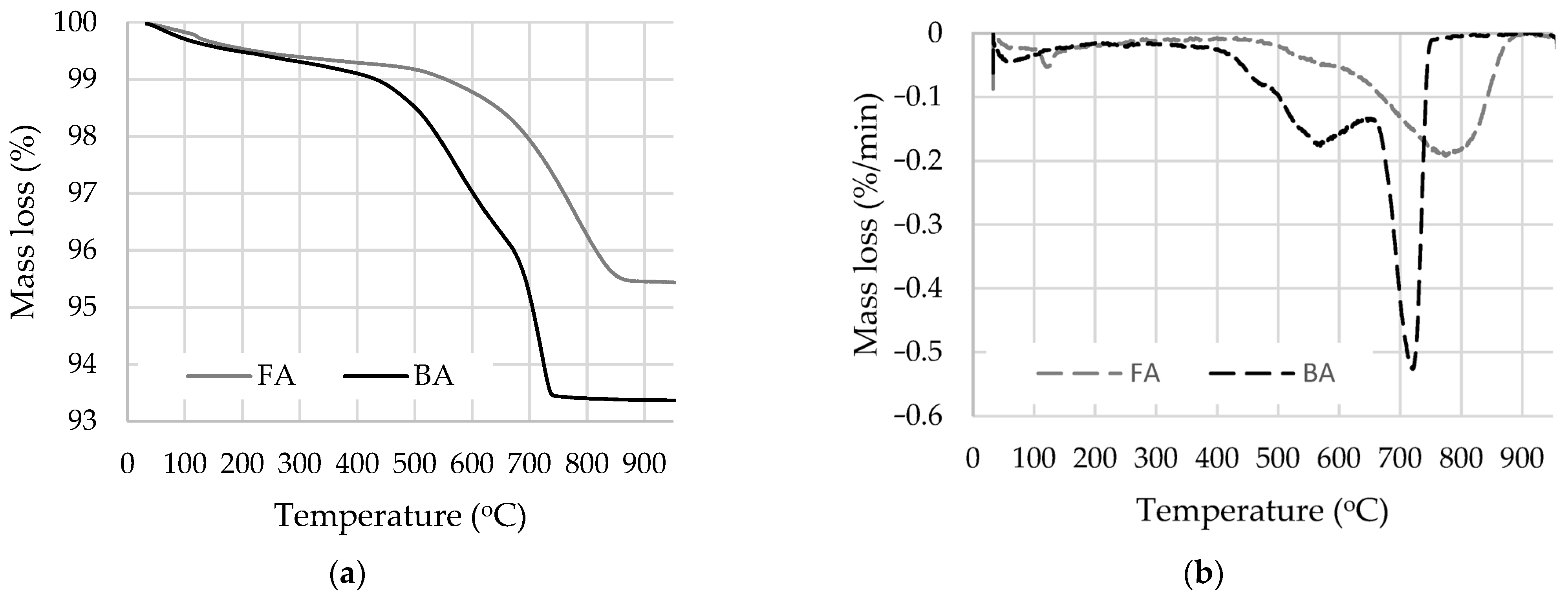

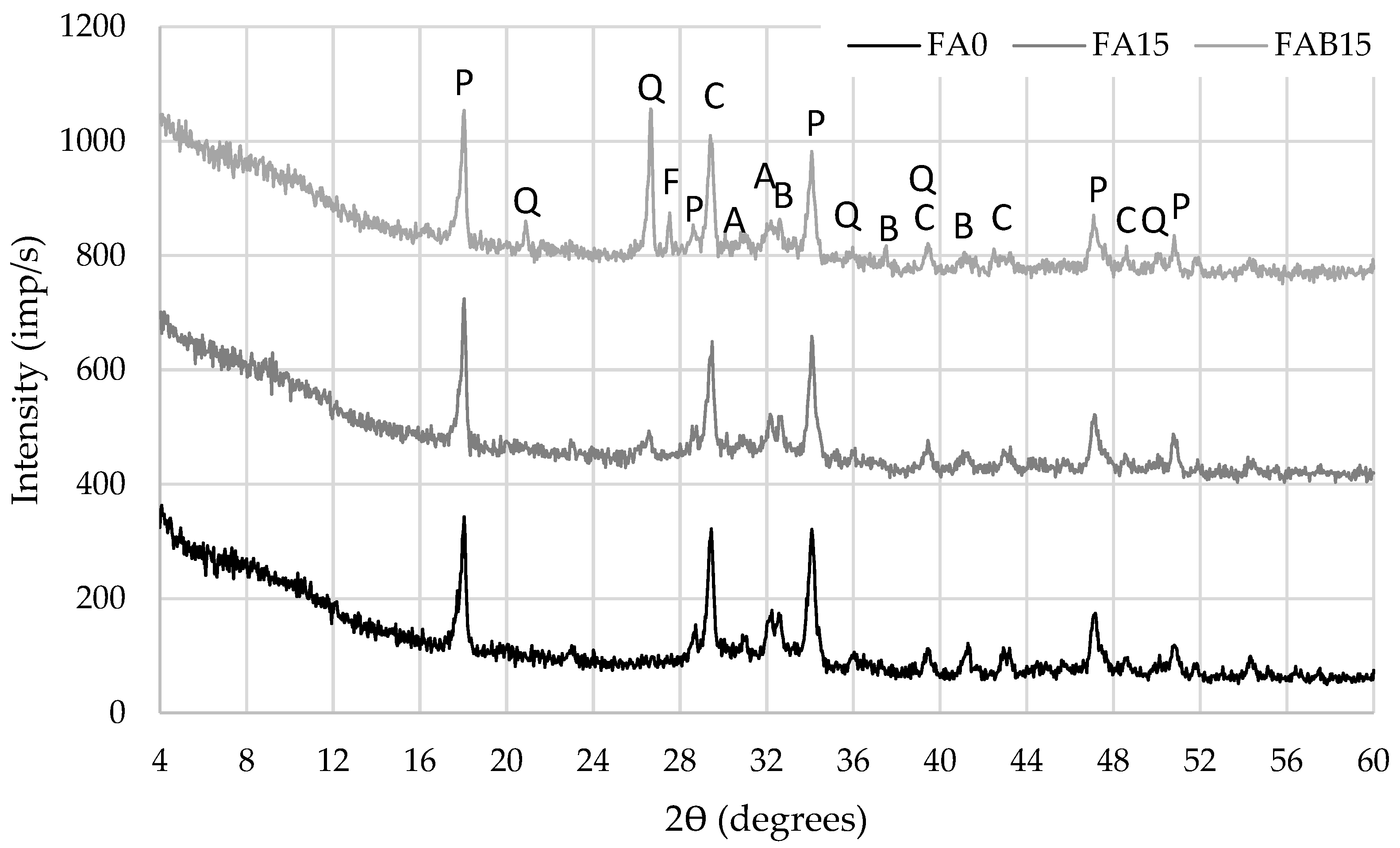

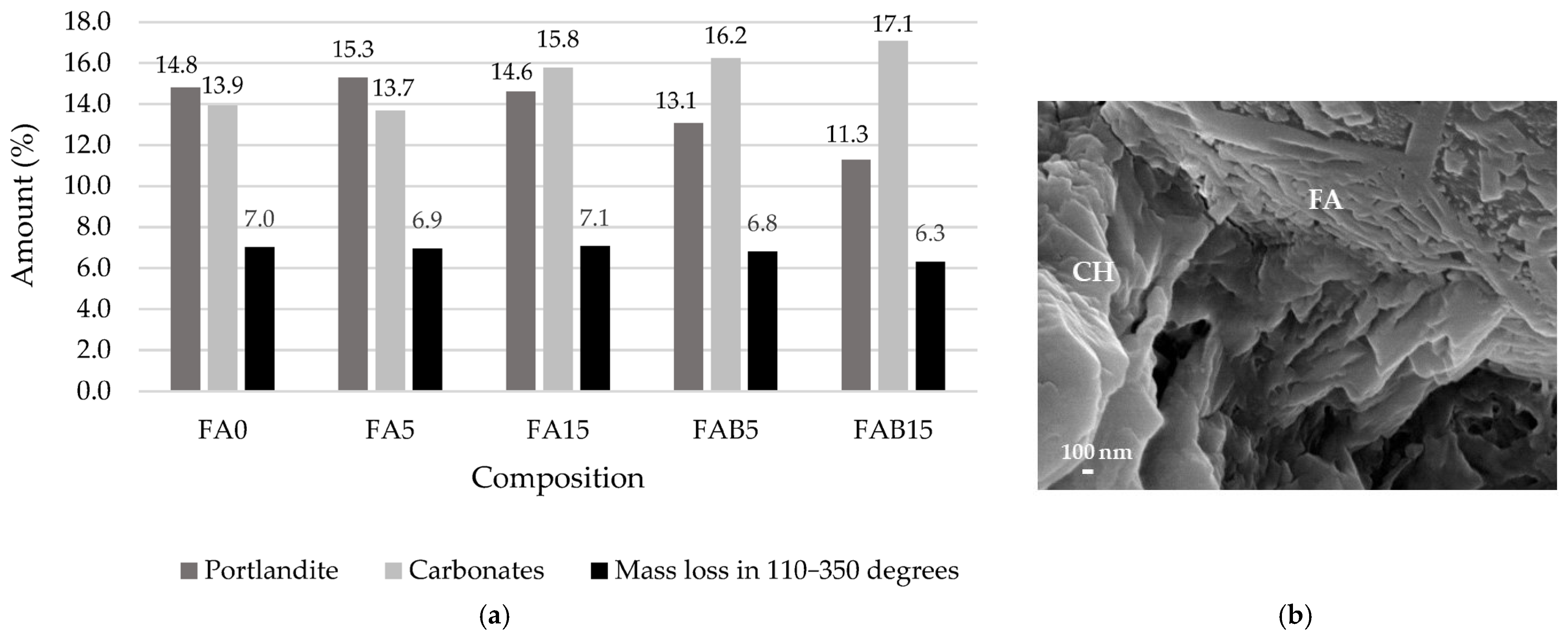

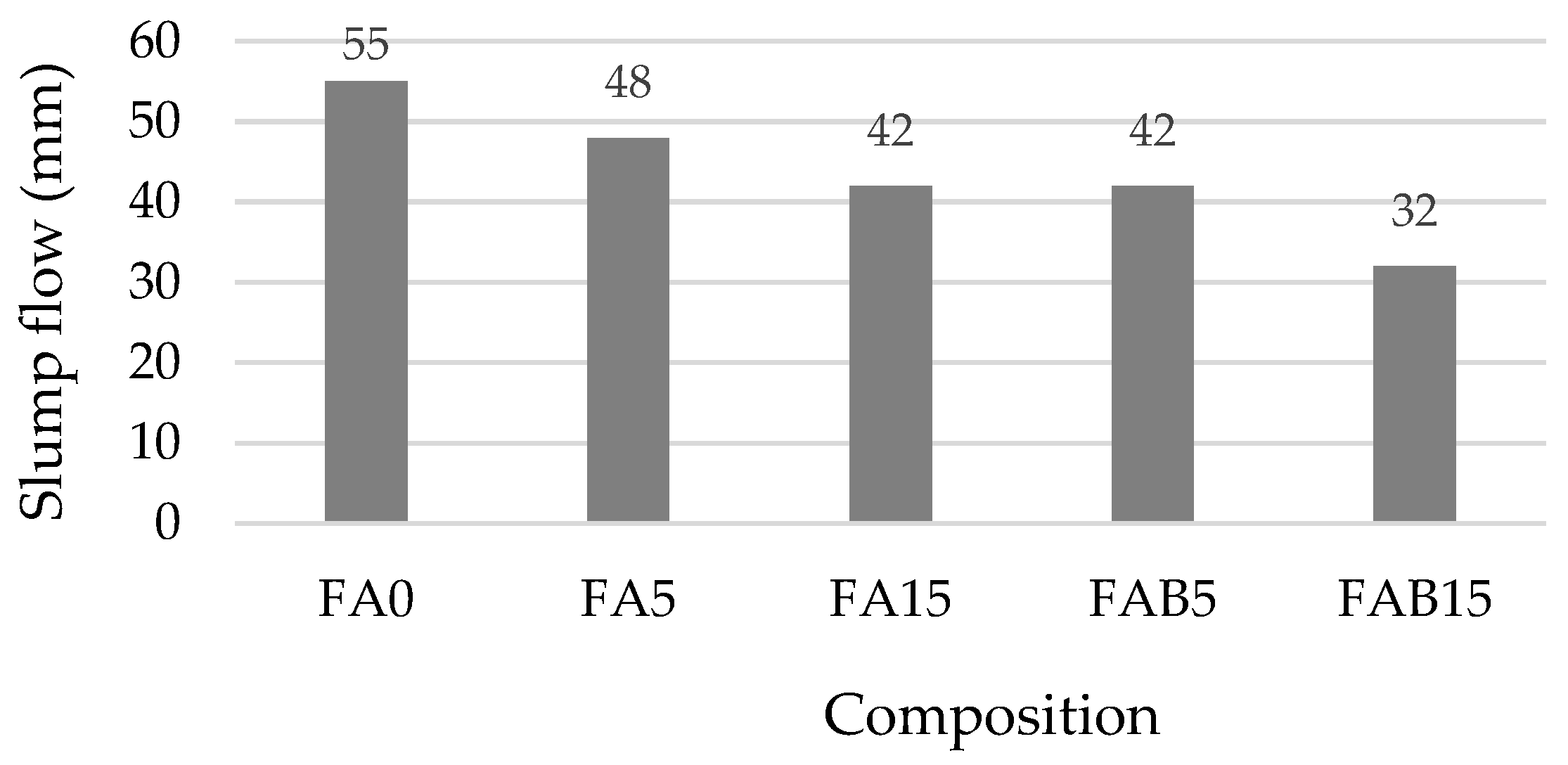
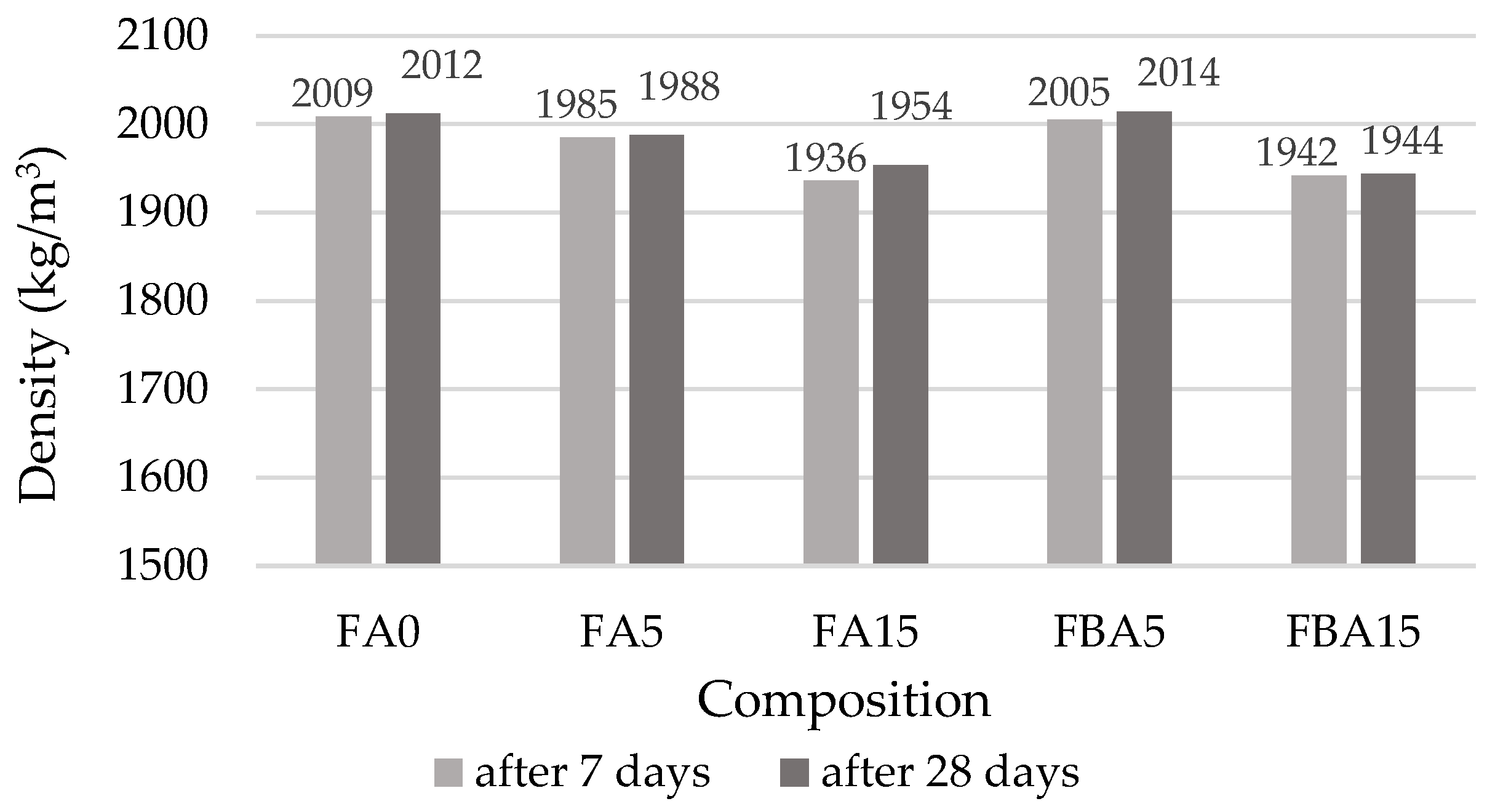


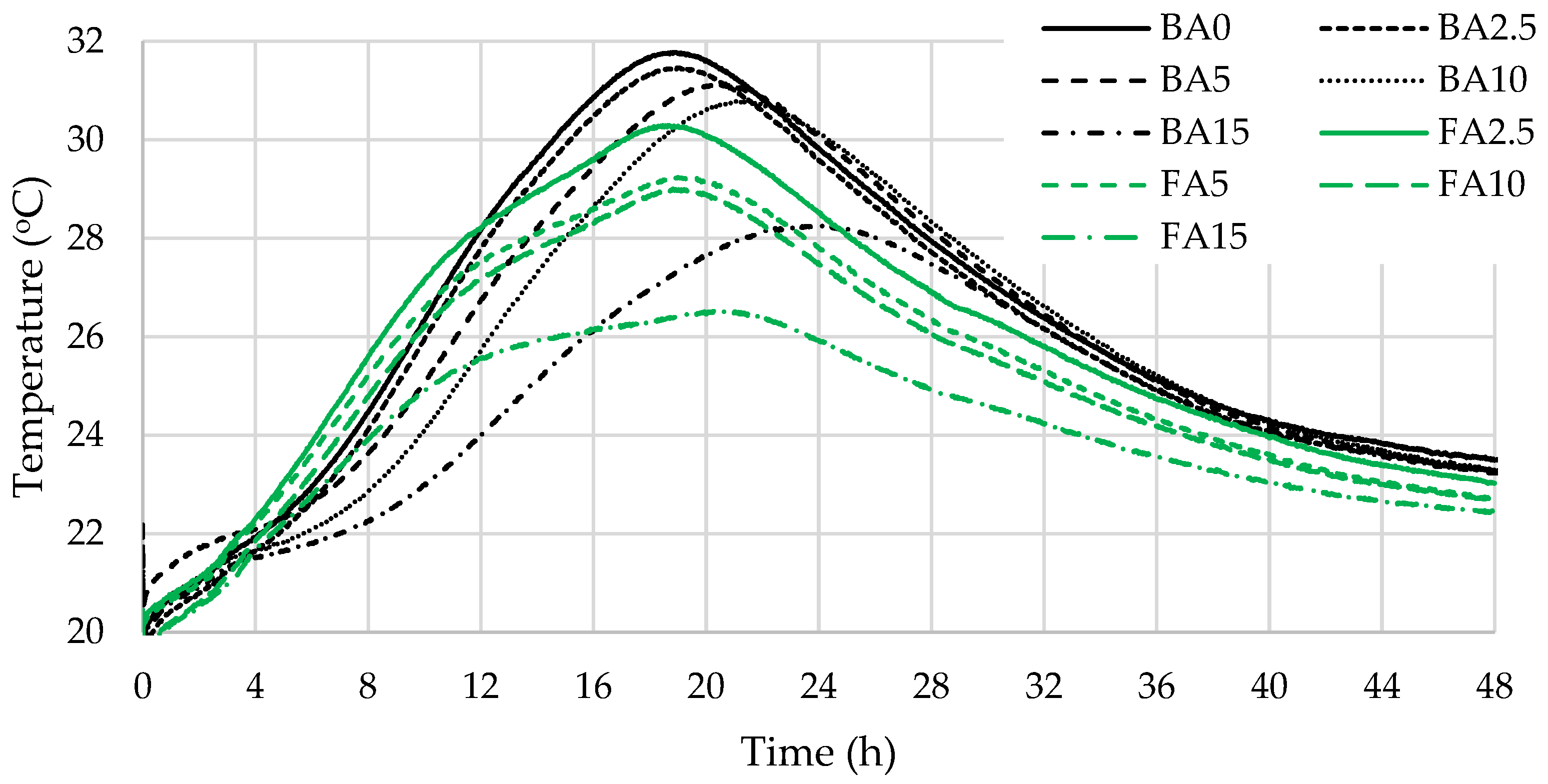
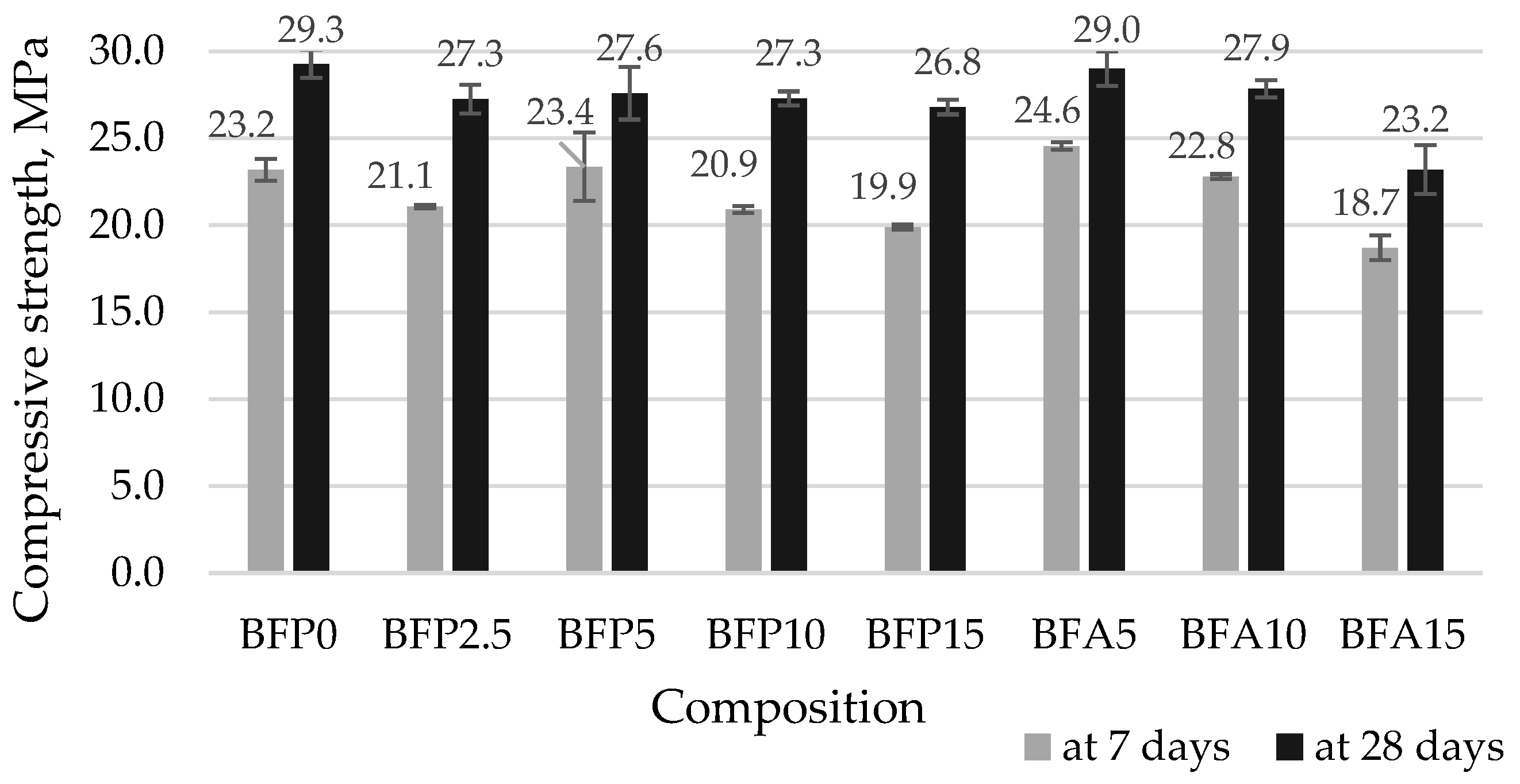
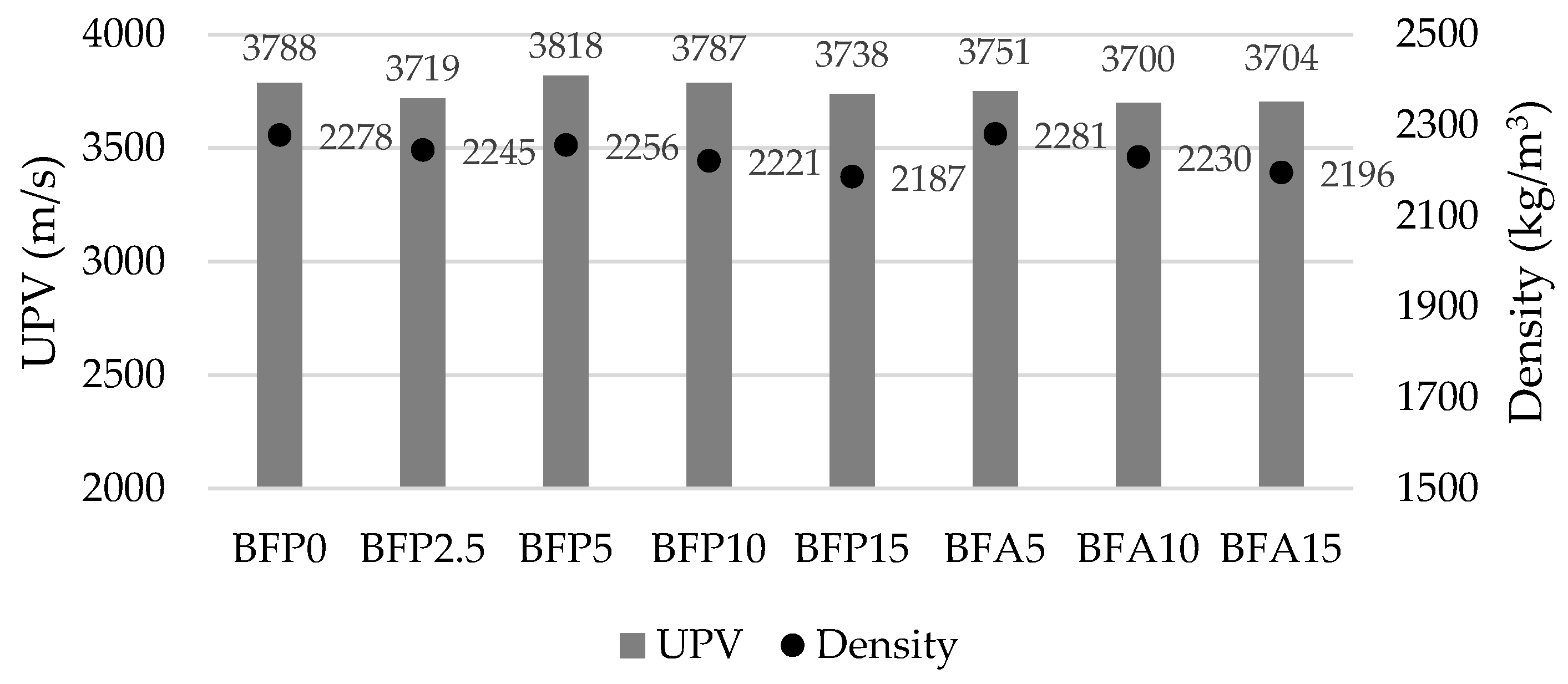


| Compound | Composition | ||
|---|---|---|---|
| CEM II | FA | BA | |
| SiO2 | 18.4 | 54.60 | 20.2 |
| Al2O3 | 3.98 | 25.30 | 2.31 |
| Fe2O3 | 3.24 | 4.97 | 1.46 |
| CaO | 66.2 | 2.14 | 10.9 |
| MgO | 3.46 | 1.80 | 1.71 |
| SO3 | 2.64 | 0.37 | 0.78 |
| K2O | 1.16 | 2.80 | 3.41 |
| Na2O | 0.19 | 0.84 | 0.28 |
| Cl | - | - | 0.13 |
| CO2 | - | n.a. | 56.1 |
| TiO2 | 0.30 | 1.07 | 0.11 |
| P2O5 | 0.07 | 0.55 | 2.13 |
| BaO | - | 0.15 | 0.05 |
| SrO | 0.09 | 0.07 | 0.02 |
| Mn3O4 | - | 0.06 | - |
| MnO | 0.06 | - | 0.23 |
| LOI | - | 4.37 | 4.05 |
| Mix Designation | Cement | FA | BA | W/S |
|---|---|---|---|---|
| FA0 | 100 | 0 | 0 | 0.35 |
| FA5 | 95 | 5 | 0 | 0.35 |
| FA15 | 85 | 15 | 0 | 0.35 |
| FBA5 | 90 | 5 | 5 | 0.35 |
| FBA15 | 70 | 15 | 15 | 0.35 |
| Mix Designation | Cement | FA According to Cement | BA According to Cement | Sand | W/(C + FA + BA) |
|---|---|---|---|---|---|
| FA0 | 23.50 | 0 | 0 | 76.5 | 0.35 |
| FA2.5 | 22.91 | 2.5 | 0 | 76.5 | 0.35 |
| FA5 | 22.33 | 5 | 0 | 76.5 | 0.35 |
| FA10 | 21.15 | 10 | 0 | 76.5 | 0.35 |
| FA15 | 19.98 | 15 | 0 | 76.5 | 0.35 |
| BA2.5 | 22.91 | 0 | 2.5 | 76.5 | 0.35 |
| BA5 | 22.33 | 0 | 5 | 76.5 | 0.35 |
| BA10 | 21.15 | 0 | 10 | 76.5 | 0.35 |
| BA15 | 19.98 | 0 | 15 | 76.5 | 0.35 |
| Mix Designation | Binder (Cement + FA) | BA | Sand | Crushed Granite | PP Fiber | SP | W/B | |
|---|---|---|---|---|---|---|---|---|
| Cement | FA | |||||||
| BFP0 | 300 | 0 | 0 | 980 | 1000 | 4.0 | 3.0 | 0.55 |
| BFP2.5 | 292.5 | 7.5 | 24.5 | 955.5 | 1000 | 4.0 | 3.0 | 0.55 |
| BFP5 | 285 | 15 | 49 | 931 | 1000 | 4.0 | 3.0 | 0.55 |
| BFP10 | 270 | 30 | 98 | 882 | 1000 | 4.0 | 3.0 | 0.55 |
| BFP15 | 255 | 45 | 147 | 833 | 1000 | 4.0 | 3.0 | 0.55 |
| BFA5 | 285 | 15 | 0 | 980 | 1000 | 4.0 | 3.0 | 0.55 |
| BFA10 | 270 | 30 | 0 | 980 | 1000 | 4.0 | 3.0 | 0.55 |
| BFA15 | 255 | 45 | 0 | 980 | 1000 | 4.0 | 3.0 | 0.55 |
| Designation of Concrete | Open Porosity Pa, % | Total Porosity Pt, % | Closed Porosity Pu, % | Kf | Predicted Freeze–Thaw Resistance, Cycles |
|---|---|---|---|---|---|
| BFP0 | 11.23 | 15.62 | 4.38 | 4.34 | 680 |
| BFP2.5 | 11.32 | 16.84 | 5.53 | 5.43 | 770 |
| BFP5 | 11.62 | 16.43 | 4.81 | 4.60 | 690 |
| BFP10 | 11.64 | 17.73 | 6.09 | 5.81 | 780 |
| BFP15 | 11.52 | 19.01 | 7.49 | 7.22 | 830 |
| BFA5 | 9.31 | 15.89 | 6.57 | 7.84 | 880 |
| BFA10 | 10.41 | 17.59 | 7.17 | 7.65 | 850 |
| BFA15 | 11.22 | 18.67 | 7.46 | 7.39 | 820 |
| Designation of Concrete | BFP0 | BFP2.5 | BFP5 | BFP10 | BFP15 | BFA5 | BFA10 | BFA15 |
|---|---|---|---|---|---|---|---|---|
| Change in compressive strength, % | −9.8 | −4.7 | −10.2 | −18.1 | −9.1 | −21.8 | −7.8 | −17.3 |
| Appearance of specimens | No visible cracks | |||||||
| Number of cycles | 150 | |||||||
Disclaimer/Publisher’s Note: The statements, opinions and data contained in all publications are solely those of the individual author(s) and contributor(s) and not of MDPI and/or the editor(s). MDPI and/or the editor(s) disclaim responsibility for any injury to people or property resulting from any ideas, methods, instructions or products referred to in the content. |
© 2024 by the authors. Licensee MDPI, Basel, Switzerland. This article is an open access article distributed under the terms and conditions of the Creative Commons Attribution (CC BY) license (https://creativecommons.org/licenses/by/4.0/).
Share and Cite
Malaiškienė, J.; Vaičienė, M. The Influence of Silica Fly Ash and Wood Bottom Ash on Cement Hydration and Durability of Concrete. Materials 2024, 17, 4031. https://doi.org/10.3390/ma17164031
Malaiškienė J, Vaičienė M. The Influence of Silica Fly Ash and Wood Bottom Ash on Cement Hydration and Durability of Concrete. Materials. 2024; 17(16):4031. https://doi.org/10.3390/ma17164031
Chicago/Turabian StyleMalaiškienė, Jurgita, and Marija Vaičienė. 2024. "The Influence of Silica Fly Ash and Wood Bottom Ash on Cement Hydration and Durability of Concrete" Materials 17, no. 16: 4031. https://doi.org/10.3390/ma17164031
APA StyleMalaiškienė, J., & Vaičienė, M. (2024). The Influence of Silica Fly Ash and Wood Bottom Ash on Cement Hydration and Durability of Concrete. Materials, 17(16), 4031. https://doi.org/10.3390/ma17164031






